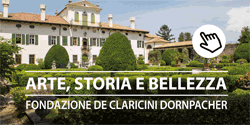Home / WHAT TO SEE /Devil's Bridge
Devil's Bridge
The Devil's Bridge is one of the symbols of Cividale del Friuli. Boldly suspended on the Natisone River is wrapped in legend. The two banks were joined, at least from the 1200's, by a wooden passage, replaced, after various inconclusive attempts, by a stone bridge planned by lacopo Dugaro from Bissone, who began the construction in 1442. The job, slow and contrasted by adversity of varied nature, continued five years after under the guide of Erardo (or Everardo) from Villaco, the former collaborator of Dugaro, that perhaps died of plague or, according to other versions, he gave up without completely honouring his contractual obligation. When the master builder Erardo died, Bartolomeo delle Cisterne finished the long desired bridge, that according to a notarialIl ponte del Diavolo nel 1917 act, was paved in the 1501 and in the 1558. Its ends were defended by towers, pulled down around the second half of the past century. Works of restoration followed one another in the course of the ages in order to maintain in full efficiency the indispensable passage, that it had to support the impetuous floods of the river. In 1843, during the works of reinforcing the central pillar, they recovered two important stones of Roman age, now in Museum.
The fate of the bridge had a tragic epilogue the 27th of October 1917 when, during the defeat of Caporetto, it was blown up attempting to slow down the enemy. A useless destruction, as the Imperial Army crossed the river the same evening.The bridge was however reconstructed in short times, by the Germans with local skilled workers, keeping the ancient structure following the precise reliefs executed years before by the engineer Ernesto de Paciani of Cividale. The street was widened by two meters.
Already the 18th of May 1918, the new bridge was solemny inaugurated. But it had short life for the 29th Il ponte del Diavolo nel 920of April 1945 the Germans tried to blow up, but this time it did not suffered many damages. It therefore remained unchanged in its original lines, only the parapets and irony loops have been replaced with the current parapet, perhaps aesthetically less well-chosen, but able to mitigate violent squalls of wind that run over the bridge in winter. The rocky walls the arches of the bridge rest on have been recently reinforced, they are different, one is of m. 22 and the other of m. 18, with a height of m. 22.5. The central pillar rests on a natural rock, protruding nearly in the center of the bed river.The popular fantasy has connected the construction of the bridge to the supernatural, giving origin to the demoniac legend, diffused in innumerable variants, according to which the devil would have facilitated the construction of the bridge in exchange of the soul of the first person passing through. To carry out in the short space of one night the Evil One bothered also his mother, and she carried in her apron the central imposing rock. But the inhabitants of Cividale mocked the devil, sending through the new passageIl ponte del Diavolo adesso an animal, dog or cat according to the versions. The admirable buliding inspired the arts: writers have dedicated to it pages of intense poetry, while skillful painters have reproduced it in their works, fixing shapes and colors, with the transparency of waters.
On the left bank of the river, the wiew of the town deserves to have some photos taken and one can go down to the gravelley river bed from a stairway, that starts from the boundary of the parapet, on the right. From the bottom, the two archs reveal all their majesty and a thought goes to the inventor of the brilliant realization that, after many centuries, is still in a position to excite wonder and admiration. The new belvedere, realized behind the close church of S. Martino, gives the possibility to enjoy a wonderful landscape. From here the colored houses are visible, the animated running after one another of loggias and balconies, the bell towers and on the background the hilly reliefs and the Matajur (m. 1641) and the Black Mount (m. 2245). Westwards the river is furrowed by the large arch of the new bridge, that from 1988 it joins the two sides of the river with its futuristic structure..
Testi tratti dalla guida Storico Artistica di Claudio Mattaloni






